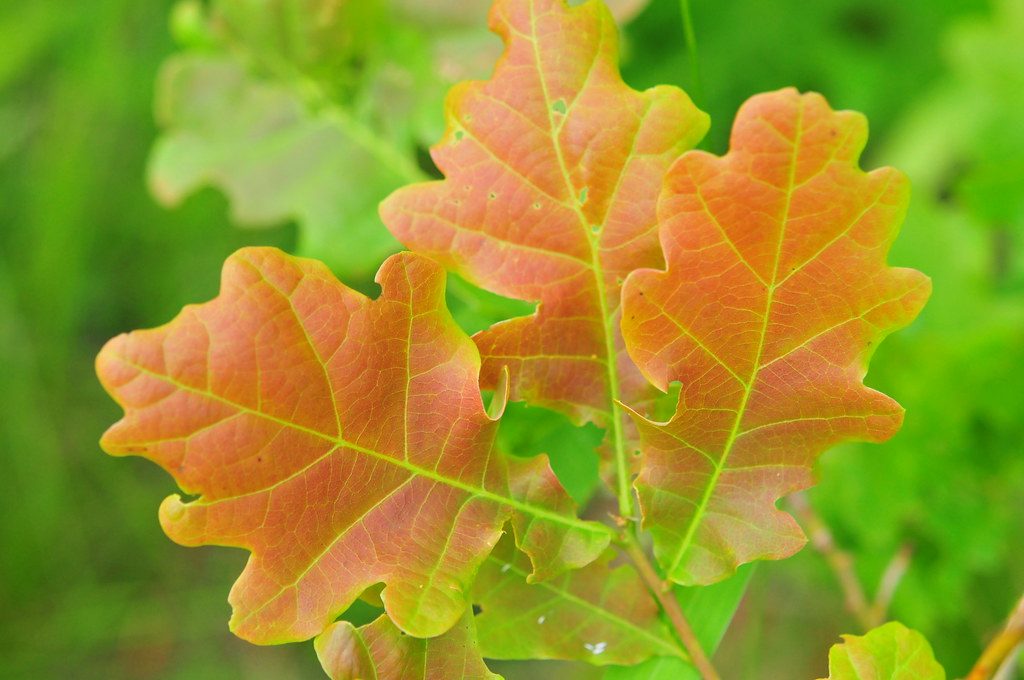Modern Druidry is a nature-based spiritual path that draws inspiration from many sources – archaeology; the words written by classical writers such as Pliny and Caesar; mythology; the explorations of the renaissance Druids and poets of the 1700s such as Williams Blake, William Stukeley and Iolo Morganwg; the ancient sites left by ancient ancestors; folklore; the work of magical Victorian groups such at the Hermetic Order of the Golden Dawn; and of course the cycles of Nature.
It is a modern tradition that takes its inspiration from ancient traditions, yet is also firmly rooted in the present moment.
After nearly 30 years of walking this Path, I’m very comfortable with the fact that this is something relatively new (well, 300 years old) – it is a Spiritual Path which has blossomed from the earth and soil of a planet breaking from the weight of human-constructed detachment. From a desperate need for us to reconnect with the Natural Worlds. A Path that quite openly shows us that it’s not all about us, it’s about Us – a way humans can recognise that the Natural World is not here for our dominion, but instead, we are a part of the Natural World. That when we passively watch a David Attenborough nature program, those beings we see are our Brothers and Sisters with whom we share this incredibly vibrant, alive, and magical planet. We need to acknowledge that there is no separation between us because we’ve been doing that for 2000 years and it’s not working.
Over the years I’ve been asked many times what Druidry is to me and the conclusion I’ve come to is: It’s a Spiritual Path that teaches and encourages a closer and deeper relationship with the Natural World, both seen and unseen.
Now people say that if you gathered 50 Druids in a room together and asked them that question you’d get 51 different answers, and that is probably true. There would be many more personal details to add to the definition I’ve just given – some may be Polytheists and believe in many Gods, others Atheists, Animists, Monotheists, and Pantheists. Not all would hold the same political views and the views they hold would also inform their Druid path. There would definitely be a hierarchy of importance, but I think what I’ve said above is something we would all share, and where we differ is the detail that surrounds that common ground.
We care for the Earth, and the way we step into a deeper relationship with Nature is to stop once every 6 weeks or so to mark one of the spokes of what we call the Wheel of the Year.
The modern Wheel of the Year is a blending of two festival cycles that was created in the 1950s by two gentlemen, Gerald Gardner (who founded the Gardnerian Tradition of Wicca) and Ross Nichols (who founded the Order of Bards Ovates and Druids). The way it happened has been written about many times so I won’t repeat it here – it is told in much more detail in Ronald Hutton’s book Triumph of the Moon. They brought together four ancient festivals – Imbolc, Beltane, Lughnasadh and Samhain, with four Solar dates – the Winter Solstice, Spring Equinox, Summer Solstice and Autumn Equinox, and thus the modern Wheel of the Year was born.
It is a Wheel, so has no real beginning nor end, so people are free to see its beginning at different places. For me, it begins with the rebirth of the Sun at the Winter Solstice. The time of the longest night and the beginning of solar Winter. Solstice means ‘Sun in stasis’ or ‘Sun stands still’ and at the time of the Winter Solstice and for three days, the Sun travels at its lowest arc across the sky. But after those three days, that arc makes a slightly visible move upwards. That move upwards would be around the 25th of December – you know that date, is it any surprise that the date of the birth of the ‘Son’ was placed at the time that for millennia humans marked the rebirth of the ‘Sun’? I don’t think so. So the Sun is reborn at the time of the Winter Solstice. Folklore and folk traditions, plus the ponderings and writings of modern poets, have marked and added to the lore surrounding the Winter Solstice with battles of Oak and Holly Kings for the rulership of the Waxing Year, kissing under the mistletoe, lighting a candle at the time of the Solstice itself at the darkest moment of the year. To go out and do a ritual at the Winter Solstice, to see the landscape around you, taste the chill air, touch the ice, see the mist of your own breath, all of these things remind us where we are in the seasonal cycle.
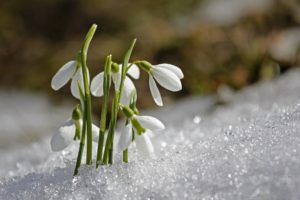 The Wheel moves on to Imbolc/Candlemass (marked around the time of the 1st/2nd February). This is seen by many as the first spring festival. It might seem strange to celebrate the arrival of Spring at, what for many, is the coldest time of the year. But if you look carefully, you will see the arrival of the first flowers, the Snowdrops; you will see the arrival of the very early Spring lambs in the fields.
The Wheel moves on to Imbolc/Candlemass (marked around the time of the 1st/2nd February). This is seen by many as the first spring festival. It might seem strange to celebrate the arrival of Spring at, what for many, is the coldest time of the year. But if you look carefully, you will see the arrival of the first flowers, the Snowdrops; you will see the arrival of the very early Spring lambs in the fields.
Here is a poem I wrote some years ago expressing my feelings about this festival:
As the dark, cold morning gives way to light,
And the world shows its face dazzling in her nakedness,
So the twigs and leaf-bare branches,
Bow to the passing dance
Of old Jack Frost.
His crystal breath on the earth,
And the corners of houses weep icicles of joy.
But where is the Sun’s warmth?
Where is life?
A small flower, delicate and pure-white,
Looks to the earth,
As if talking to the waiting green,
“Not yet,” it seems to whisper.
“When I fall, then you can return.”
And she nods her head,
as the Lady passes by,
Leaving more flowers in Her wake.
The Wheel turns to the Spring Equinox. The time of equal day and night. The time of balance and a fulcrum of the year. Ahead lies much lighter days, behind us lay the dark days of Winter. This is the beginning of Solar Spring, and we can see Spring clearly arriving. Daffodils and crocuses are in bloom, the early trees are in leaf, and some are beginning to blossom bringing with them the Blackthorn Winter, as the blossom of the blackthorn trees arrives before the greenery of their leaves. If the Winter Solstice celebrated the rebirth of the Sun, then the Spring Equinox celebrates the rebirth of the Green, and this is done by giving eggs (often chocolate eggs!). A tradition we also see at the time of Easter.
The Wheel moves on the Beltane/May Day (around the 1st of May). I say around the 1st of May because Nature doesn’t always comply with the calendar. The Solstices and Equinoxes arrive dead on time as the Sun moves into areas of the sky, but the seasonal festivals are led by signs within Nature here on Earth. For me, living in the South of England I mark the arrival of Beltane with the coming of the May Queen in her guise as the flowers of the May Tree, the Hawthorn. Now, one Mayflower Beltane does not make. I mean Beltane is here when the hedgerows are literally dripping with long arms of Mayflowers. To me, that is the virgin skin of the land – untouched, fertile, fecund and beautiful. The Wheel of the Year is an ever-turning celebration of birth, death, harvest and rebirth. We buy our food, often items way out of season, packaged on supermarket shelves. The age when the people of the village would get together to bring in the harvest has been and gone and with it much of our connection with our food. I heard a Druid once say, “My Druidry has nothing to do with fertility.” And I wondered, how they think that are alive, and how they think they are staying alive. If I consider the foundation of the Wheel of the Year for me it is a continuous cycle of Thanksgiving, for the life I have, and the life that is given to sustain me. So to me, Beltane is about the fertility of the land, without which I would not be here.
The Wheel moves on to the Summer Solstice – if the Winter Solstice marked the rebirth of the Sun, then the Summer Solstice is the Sun at its Zenith. On this day the arc of the Sun is at its highest and, again, for three days it moves that same arc before on the 25th of June it begins its descent back down. After the Summer Solstice, the days are getting shorter again and we have entered the Waning Year. If there is one date that is associated with modern Druids it is the Summer Solstice, but that is mainly because of one particular Druid group who meet at Stonehenge in their white robes – quite a sight to see, and then in the 90s, there was the Stonehenge Free Festival. Why are we so drawn to mark this date? Is it because we know, somewhere deep inside us, that life on this planet, all life, is dependent on the stellar dance and relationship between the Earth and the Sun? I think so. Just like the birds sing the dawn chorus so we sing our chorus at the Winter Solstice, the dawn of the year, and then we sing again at the Summer Solstice – the noon chorus. Old and new folklore and traditions repeat here with the next battle of the Oak and Holly King, but this time for rulership over the Waning Year.
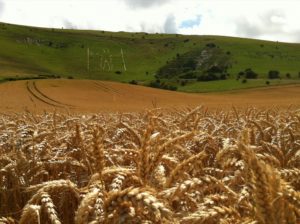 The Wheel moves on to Lughnasadh/Lammas – on or around the 1st of August. This marks the first harvest, the grain harvest. People walk the Druid Path all over the world, and this cycle doesn’t always fit with the landscape. Here in the South of England, it works perfectly, but in the Southern Hemisphere the Equinoxes and Solstices are reversed, and many also reverse the four agricultural festivals also. In many places in the Northern Hemisphere, the grain is either not being harvested on the 1st of August, or it’s already in. The decision is to still mark Lughnasadh/Lammas by the grain harvest, or is there something else happening in the natural world around that time that shows change? None of this is written in stone. We’re told the Druids never wrote anything down, and I think I know why – because the Book is already written – it’s the Book of Nature. Let Nature tell you the story of the Wheel of the Year where you live if it doesn’t match the cycle and signs created by Gardner and Nichols 70 years ago. Another reason not to write these things down is that they can become seen as some kind of liturgy, rules to conform to. This is about a relationship with the natural cycles, not trying to shoehorn a seasonal cycle into somewhere else. Let Nature always be your guide when it comes to the Wheel of the Year.
The Wheel moves on to Lughnasadh/Lammas – on or around the 1st of August. This marks the first harvest, the grain harvest. People walk the Druid Path all over the world, and this cycle doesn’t always fit with the landscape. Here in the South of England, it works perfectly, but in the Southern Hemisphere the Equinoxes and Solstices are reversed, and many also reverse the four agricultural festivals also. In many places in the Northern Hemisphere, the grain is either not being harvested on the 1st of August, or it’s already in. The decision is to still mark Lughnasadh/Lammas by the grain harvest, or is there something else happening in the natural world around that time that shows change? None of this is written in stone. We’re told the Druids never wrote anything down, and I think I know why – because the Book is already written – it’s the Book of Nature. Let Nature tell you the story of the Wheel of the Year where you live if it doesn’t match the cycle and signs created by Gardner and Nichols 70 years ago. Another reason not to write these things down is that they can become seen as some kind of liturgy, rules to conform to. This is about a relationship with the natural cycles, not trying to shoehorn a seasonal cycle into somewhere else. Let Nature always be your guide when it comes to the Wheel of the Year.
The Wheel moves on to the Autumn Equinox – we find ourselves once more at a time of balance, the balance of equal day and night, but this time the fulcrum is falling towards the dark of Winter, not the light of Summer. The hedgerows are heavy with berries and fruit, the light can visibly change as the sun moves ever downwards. For many, this is another time of Harvest. We see that in our schools with the Harvest Festival. As we step out of the ritual of the Autumn Equinox we step consciously into the first shadows of darkness, as the nights really begin to draw in.
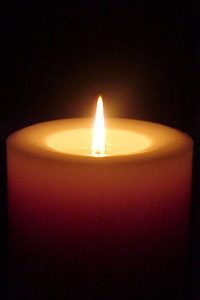 And the Wheel moves on to Samhain, on or around the 31st of October. Folklore says that the Veil between the Worlds is at its thinnest at this time of year. The Veil also thins at Beltane/May Day too, but it is at Samhain that we remember those who have walked the path that leads to the Oceans of the West, the Path of those who have died. It is said that all the time the names of those we love are spoken upon the wind, so they will know that they are remembered, and that is what many of us do at Samhain. The Circle is cast, the mists of the Otherworld are called forth, and we step into those mists, calling out the name of those we loved in life. Through the thin Veil, they hear their names being called and know that there are still those who love and remember them, for what is remembered never truly dies. we share a symbolic feast with them in their honour. It’s an emotional time. Of course, this thinning of the Veil has led to the secular festivities of Hallowe’en that take place at the same time. The people of the Otherworld also ride out at both Beltane and Samhain, and this can be seen in the chaos of the weather sometimes, in the general feeling of the time of year, and in the armies of children doing Trick or Treat.
And the Wheel moves on to Samhain, on or around the 31st of October. Folklore says that the Veil between the Worlds is at its thinnest at this time of year. The Veil also thins at Beltane/May Day too, but it is at Samhain that we remember those who have walked the path that leads to the Oceans of the West, the Path of those who have died. It is said that all the time the names of those we love are spoken upon the wind, so they will know that they are remembered, and that is what many of us do at Samhain. The Circle is cast, the mists of the Otherworld are called forth, and we step into those mists, calling out the name of those we loved in life. Through the thin Veil, they hear their names being called and know that there are still those who love and remember them, for what is remembered never truly dies. we share a symbolic feast with them in their honour. It’s an emotional time. Of course, this thinning of the Veil has led to the secular festivities of Hallowe’en that take place at the same time. The people of the Otherworld also ride out at both Beltane and Samhain, and this can be seen in the chaos of the weather sometimes, in the general feeling of the time of year, and in the armies of children doing Trick or Treat.
And the Wheel turns and brings us back to the Winter Solstice. Ever onward, ever turning. No beginning, and no end. One of the best ways to connect with the Wheel of the Year is to go outside to the same place for each festival. Then once you’ve been there for a full turning, go back for the second year. Looking around at the same landscape through the turning of the Wheel can really connect you to the seasons, and the area you live in. Why have I spent so much time on the Wheel of the Year? Because to me, it is the most wonderful gift of the modern Pagan traditions. A beautiful Mandala that holds in it so much more than the dates – in it, there are the Elements, the cycles of day and night, of life, death and rebirth – the symbolism is deep, mystical, and ours.
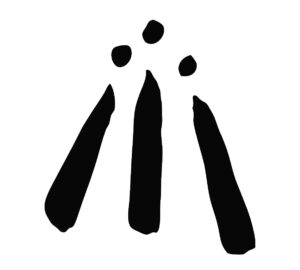 No intro to modern Druidry is complete without the energy called the Awen. Written about in a number of ancient poems by the Bard Taliesin – “The Awen I sing, from the Deep I bring it”, he says. So the Awen is to be sung, and its origin is in The Deep, which in Brythonic folklore is a place called ‘Annwfn’.
No intro to modern Druidry is complete without the energy called the Awen. Written about in a number of ancient poems by the Bard Taliesin – “The Awen I sing, from the Deep I bring it”, he says. So the Awen is to be sung, and its origin is in The Deep, which in Brythonic folklore is a place called ‘Annwfn’.
The Awen is brewed within the Cauldron of Cerridwen, the Mother of Awen. Three drops of the brew bestow the gift of wisdom and insight, to know all that is, was, and ever will be. The story is in my song Cerridwen and Taliesin.
The Awen is the Gift of Poetic Inspiration. The poems of Taliesin, myths and legends of Y Mabinogi hold within them great lessons. We see the energy of Awen in many other ancient myths and legends all across the world. The poems of the great Bards and Skalds all point to the connection to the Natural World I’ve been writing about. When Taliesin speaks in his poetry of being ‘all things’, it is because he entered into that direct relationship with Nature and knew, in that moment, he was a part of everything. That there was no separation.
That to me is the Mystery.
That to me is the Quest of the Druid.
That, to me, is the common ground we all share.
That, to me, is Druidry.
